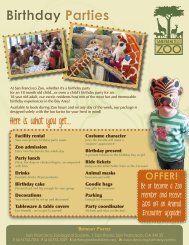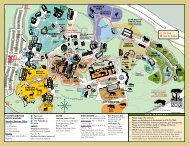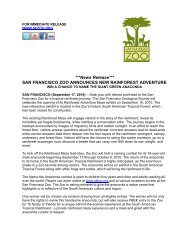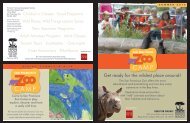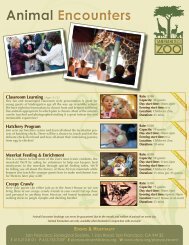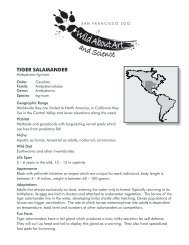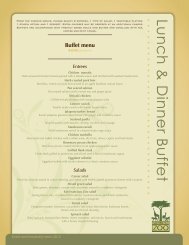Zoo Views - San Francisco Zoo
Zoo Views - San Francisco Zoo
Zoo Views - San Francisco Zoo
You also want an ePaper? Increase the reach of your titles
YUMPU automatically turns print PDFs into web optimized ePapers that Google loves.
Dentzel Carousel<br />
The Carousel is one of the last machines constructed<br />
by William H. Dentzel, whose family became renowned<br />
for their intricate woodcarving. Built in 1921, the rare<br />
“menagerie carousel” – one of only 14 left in the world<br />
and one of seven Dentzel carousels remaining in the<br />
United States – showcases the lavish and expensive artwork<br />
that ended with the Great Depression. It came to the <strong>Zoo</strong><br />
in 1925 from the defunct Pacific City Amusement Park and<br />
was one of the first attractions to be located on the current<br />
site of the <strong>Zoo</strong>.<br />
The 50 hand-carved wooden animals – including fanciful<br />
horses with finely detailed braids, harness bands, saddle<br />
blankets, and flowing manes and tails – were all handpainted<br />
with whimsical details and inset with “jewels.”<br />
Other animals in the menagerie include a giraffe, ostrich,<br />
tiger, lion, pig, rabbit, and cat.<br />
The years of constant use and sea air take their toll<br />
on the painted animals. In 1978, the <strong>San</strong> <strong>Francisco</strong><br />
<strong>Zoo</strong>logical Society funded a $100,000 restoration project<br />
and in 1994, a mechanical overhaul was undertaken.<br />
In September 2000, under the watchful eye of the <strong>San</strong><br />
<strong>Francisco</strong> Art Commission, Brass Ring Entertainment of<br />
Sun Valley California was enlisted to dismantle and handrestore<br />
each of the carousel animals to its former splendor<br />
in an “extreme makeover” driven by dedicated members<br />
of the <strong>Zoo</strong>logical Society Board of Directors. The restorers<br />
spent almost 500 hours on each animal, painstakingly<br />
recreating each detail as originally intended. In addition,<br />
the Carousel received a new set of hardened steel gears<br />
cut to the original Dentzel specification, a new drive system<br />
with electronically controlled motors, new steel bearings,<br />
new paint inside and out including the backdrop murals.<br />
Storyland/Children’s <strong>Zoo</strong><br />
Developed, opened and operated by the <strong>San</strong> <strong>Francisco</strong><br />
Recreation and Park Department in 1959, the three-acre<br />
Storyland was an outdoor playground area with play<br />
equipment and large scenes inspired by nursery rhymes<br />
and fairy tales. It was much beloved by young children,<br />
especially for its entrance through the laughing “mouth” of<br />
a castle. Just beyond lay a zany collection of 26 colorful,<br />
animated and audio play sets, depicting Humpty Dumpty,<br />
Little Red Riding Hood, Goldilocks and the Three Bears,<br />
Winnie the Pooh, Alice in Wonderland and more.<br />
In February 1964, the <strong>Zoo</strong>logical Society took over the<br />
operation of Storyland from the Recreation and Park<br />
Department. In March 1964, the Children’s <strong>Zoo</strong> was<br />
opened within Storyland as a place “where children of<br />
all ages may actually pet, hold and feed baby animals.”<br />
The Children’s <strong>Zoo</strong> featured a variety of animals and an<br />
egg hatchery. Over time, attractions such as a penguin<br />
show were added – a 20-minute performance by 12<br />
Humboldt penguins trained to box, ride a surfboard, dive<br />
and even play a piano. From time to time, baby animals<br />
from the main <strong>Zoo</strong> were cared for in the nursery, including<br />
chimpanzees and elephants.<br />
In time, the Storyland play sets were removed and animal<br />
exhibit areas were constructed. A Nature Trail pathway<br />
was added to provide visitors with opportunities to meet a<br />
variety of animals up close from youths trained to teach the<br />
public about animals. The indoor Insect <strong>Zoo</strong> got its start as<br />
a temporary exhibit in 1979 and was one of just three in<br />
the country. The Insect <strong>Zoo</strong> proved to be so popular that it<br />
became a permanent exhibit shortly thereafter.<br />
2002 <strong>Zoo</strong> opens its new main<br />
entrance, Lipman Family<br />
Lemur Forest, indoor café, <strong>Zoo</strong><br />
Street, and restored carousel.<br />
2003 First African lion cubs<br />
are born at the <strong>Zoo</strong> since 1979.<br />
The cubs are hand-reared by <strong>Zoo</strong><br />
staff following the unexpected<br />
loss of their mother.<br />
2003 A record number<br />
13 Magellanic penguin chicks<br />
hatch in the spring.<br />
2004 <strong>Zoo</strong> opens the African Savanna<br />
– a three-acre multi-species exhibit with<br />
giraffe, zebra, marabou stork, ostrich,<br />
kudu, and scimitar-horned oryx.<br />
10 <strong>Zoo</strong> <strong>Views</strong> / Winter 2009



